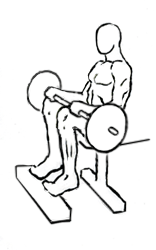Last Updated on September 26, 2014
When it comes to building a complete, balanced physique, many fitness enthusiasts focus on their upper bodies, core, or quads, often overlooking a crucial muscle group: the calves. Strong, well-developed calves not only add symmetry and proportion to the lower body but also support improved balance, mobility, and power in various athletic activities. Among the most effective exercises to target and sculpt these often-neglected muscles is the Seated Calf Raise with Barbell. This powerful move uses a straightforward setup and some essential equipment—a barbell, a bench, and a block—to deliver impressive gains in calf size and strength.
In this article, we’ll dive into why the Seated Calf Raise with Barbell deserves a spot in your lower body workout routine, how it’s performed, tips to make the most of each rep, and common pitfalls to avoid. Whether you’re a seasoned lifter or new to calf training, mastering this exercise can help elevate your results and enhance the overall definition and strength of your legs.
Why the Seated Calf Raise with Barbell?
The Seated Calf Raise with Barbell is a variation of the traditional calf raise that focuses on activating the soleus muscle, a broad, flat muscle located underneath the gastrocnemius, which is the more prominent, bulging muscle visible on the back of the lower leg. While standing calf raises primarily target the gastrocnemius, seated calf raises isolate the soleus, helping you achieve fuller calf development by working both muscles through a balanced approach. Since the soleus muscle is active when the knee is bent, exercises like the seated calf raise position you to engage and build this muscle effectively.
Beyond aesthetics, strong calves are essential for functional strength and performance. They play a key role in daily movements like walking, running, and jumping, and they’re instrumental in maintaining balance and stability. Strengthening the soleus, specifically, is especially important for those involved in activities that demand endurance and sustained power, as this muscle provides crucial support over extended periods.
Setting Up for the Seated Calf Raise with Barbell
Let’s get into the nuts and bolts of the setup. A few pieces of equipment are essential: a barbell, a bench to sit on, and a sturdy block or platform to elevate the toes. Here’s how to get started:
- Equipment Placement: Place a block or sturdy platform on the floor about one foot in front of a bench. This will be where you position the balls of your feet, with your heels free to move up and down. Make sure the block is stable enough to handle your body weight plus the weight of the barbell.
- Position Yourself: Sit on the bench, ensuring that your feet are flat on the floor to begin. Place the balls of your feet on the block so that your heels can comfortably hang off the edge, allowing full range of motion during the exercise.
- Barbell Placement: Position a barbell across your upper thighs. It’s best to use a bar pad or wrap a towel around the barbell to provide cushioning for your thighs, especially if you’re working with heavier weights. Rest your hands on the barbell to stabilize it and keep it from rolling during the exercise.
- Body Alignment: Sit up straight on the bench with a natural arch in your lower back, chest up, and core engaged. Keep your feet positioned about shoulder-width apart on the block to maintain stability and ensure even engagement of both calves.
Performing the Seated Calf Raise with Barbell: Step-by-Step Guide
Once you’re set up and seated, follow these steps to execute the Seated Calf Raise with Barbell with precision and control:
- Begin the Movement: Start by slowly raising your heels off the ground, pushing through the balls of your feet. As you lift, focus on flexing the muscles in your calves, particularly the soleus. Aim to raise your heels as high as possible, creating a strong contraction in the calves. This upward phase should be performed in a controlled manner, not rushed.
- Peak Contraction: At the top of the movement, pause briefly to maximize the contraction in your calves. This pause is where you’ll feel the deepest burn and can focus on the mind-muscle connection, ensuring the soleus muscle is doing the work.
- Lowering Phase: Gradually lower your heels back down toward the ground, controlling the descent. Avoid letting your heels drop too quickly or bouncing off the block, as this reduces the effectiveness of the exercise and increases the risk of strain or injury. Instead, aim for a slow, steady return to the starting position.
- Repetition Count: Repeat the movement for a designated number of reps, typically between 10-15 for each set, depending on your goals and experience level. For those aiming to build endurance, higher repetitions with lighter weights can be effective, while fewer reps with heavier weights are beneficial for strength and hypertrophy.
Tips for Maximizing Your Results
The Seated Calf Raise with Barbell may seem straightforward, but small adjustments can make a big difference in the quality of the workout and the results you achieve. Here are some insider tips to help you get the most out of each rep:
- Engage Your Core: Keeping your core engaged throughout the exercise will improve your stability and form, allowing for a more controlled movement. It also prevents leaning forward or backward, which can put unnecessary pressure on your lower back.
- Emphasize the Full Range of Motion: Calf muscles respond well to a full range of motion, so make sure you’re lifting your heels as high as possible during the upward phase and allowing your heels to lower fully during the descent. This ensures that the soleus is fully engaged and worked through its entire range.
- Increase the Weight Gradually: While it might be tempting to load up the barbell for quick gains, building strong calves takes time and patience. Start with a manageable weight, focusing on mastering form and control before increasing the load. As your calves adapt, you can gradually increase the weight to continue challenging the muscles.
- Consider Time Under Tension: To intensify the workout, try slowing down the movement to increase the time your muscles spend under tension. For example, count to three on the way up, pause at the top for two seconds, and then count to three on the way down. This technique boosts the demand on your calves, encouraging muscle growth and strength.
- Rest Between Sets: Allow your calves to recover by resting for about 30-60 seconds between sets. The calves are used constantly in daily activities, so giving them a break between sets helps maintain peak performance in each set.
Common Mistakes to Avoid
Just as important as following the correct form is avoiding common mistakes that can limit your results or even lead to injury. Here are some errors to watch out for when performing the Seated Calf Raise with Barbell:
- Using Too Much Weight: Overloading the barbell can compromise your form, leading to reduced range of motion and potentially straining your calves or lower back. Stick with a weight that allows you to maintain control throughout each rep.
- Bouncing at the Bottom: Lowering your heels too quickly and bouncing off the block reduces the time under tension and can place undue strain on your Achilles tendon. Focus on a slow, controlled descent to maximize the exercise’s effectiveness and protect your joints.
- Leaning Forward: Leaning forward to move the barbell can shift the load off your calves and onto your lower back. Sit upright with your back straight, engaging your core to keep the weight balanced over your calves.
- Neglecting Warm-Up: As with any exercise, warming up the muscles before jumping into a weighted calf raise can prevent injury and improve performance. Try a few minutes of light cardio or some bodyweight calf raises to get the blood flowing to the lower legs.
Benefits of Incorporating the Seated Calf Raise with Barbell
Incorporating this exercise into your routine offers multiple benefits that go beyond mere aesthetics:
- Enhanced Muscle Definition: By targeting the soleus, the Seated Calf Raise with Barbell helps create a well-rounded, defined look in the lower legs. This gives your calves a more sculpted appearance when complemented by exercises that target the gastrocnemius.
- Improved Lower Body Strength: Strong calves support all kinds of lower-body movements, including squats, lunges, and deadlifts. Calf exercises like this one build the strength and resilience needed to support heavy lifting and functional movements.
- Increased Endurance for Daily Activities: Whether you’re an athlete, a weekend warrior, or someone who loves hiking, strong calves contribute to endurance and mobility in activities that require sustained leg strength.
- Enhanced Athletic Performance: Calves play a significant role in explosive movements, such as jumping and sprinting. By strengthening both the soleus and gastrocnemius muscles, you’ll improve your ability to generate power in sports and other dynamic activities.
- Better Balance and Stability: The calves help stabilize the body and maintain balance, reducing the risk of falls or missteps. This exercise strengthens the lower legs, which is especially beneficial as we age.
Wrapping Up: Building Calves That Stand Out
The Seated Calf Raise with Barbell is a simple yet powerful exercise that can dramatically improve the strength, endurance, and appearance of your calves. By targeting the soleus muscle specifically, this move helps to create a balanced, aesthetically pleasing lower leg. With regular practice, attention to form, and gradual weight progression, you can look forward to strong, defined calves that support your overall fitness goals.
So next time you’re planning your leg day, don’t skip calf training! Add the Seated Calf Raise with Barbell to your routine and watch as your lower legs transform into a pillar of strength and symmetry. Remember, a well-rounded physique is not just about the upper body—strong legs make for a solid foundation that benefits you in every step, lift, and jump you make.








